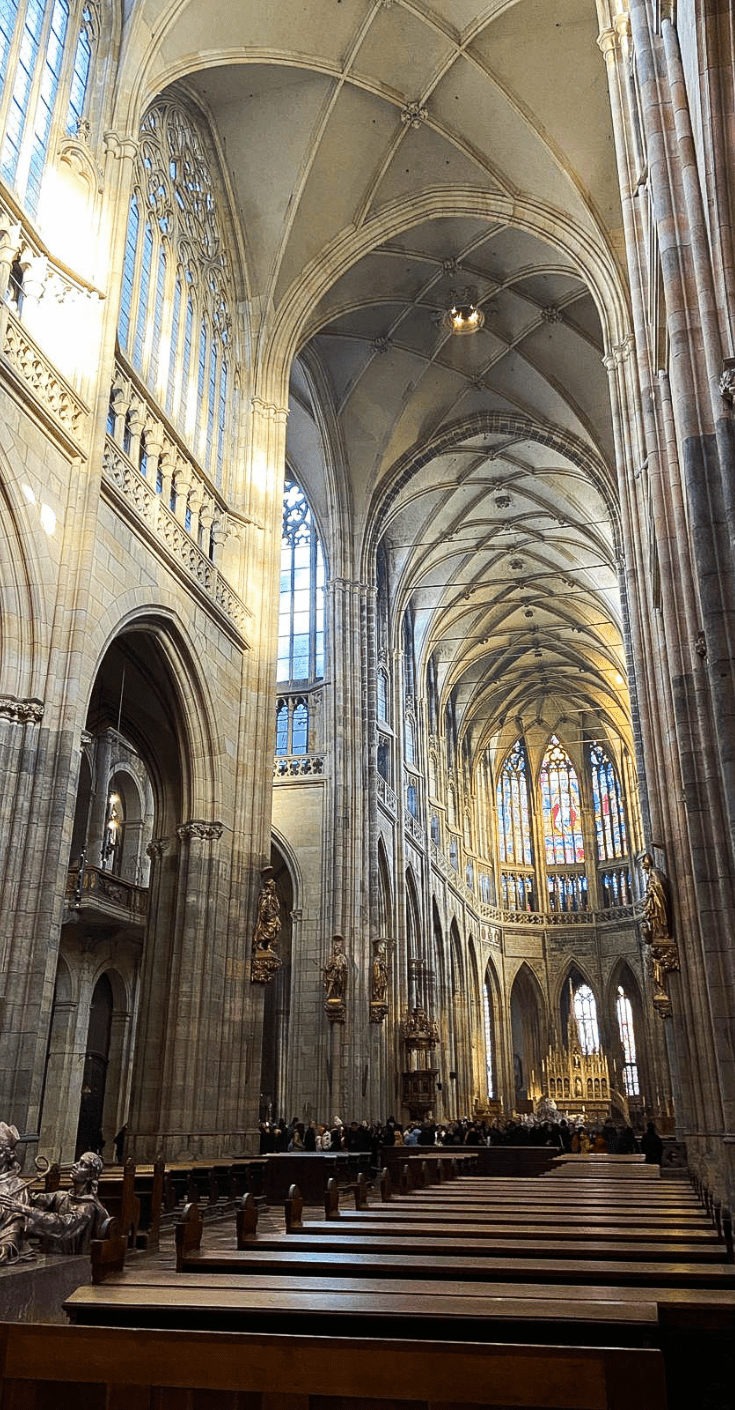Edgar Degas Best Paintings and Where to See them
If you are visiting Paris and are looking for traditional Parisian artworks to admire, you should take a look at Edgar Degas’ paintings.
His ability to capture the beauty in everyday moments, whether it’s ballerinas mid-rehearsal or workers going about their day, is truly unmatched.
Unlike other Impressionists who loved painting outdoors, Degas preferred intimate indoor settings, focusing on movement, emotion, and the little details that make life so fascinating.
His bold compositions and rich colors give his paintings a timeless energy, making them some of the most memorable works of his era.
Some of his most iconic works, like The Ballet Class and L’Absinthe, can be found in museums across the globe, from Paris to New York, but you will find a huge collection of his paintings at the Musee d’Orsay in Paris.
This guide will walk you through his best paintings and tell you exactly where to see them.
Biography
Edgar Degas (1834–1917) was a French artist best known for his innovative depictions of modern life, especially scenes of ballet dancers, theater performers, racehorses, and women in intimate, everyday moments.
Though often associated with the Impressionist movement, Degas preferred to call himself a “realist” or “independent,” blending classical techniques with bold experiments in composition, perspective, and movement.
His use of unusual angles, cropped figures, and pastel colors helped revolutionize both painting and drawing in the late 19th century.
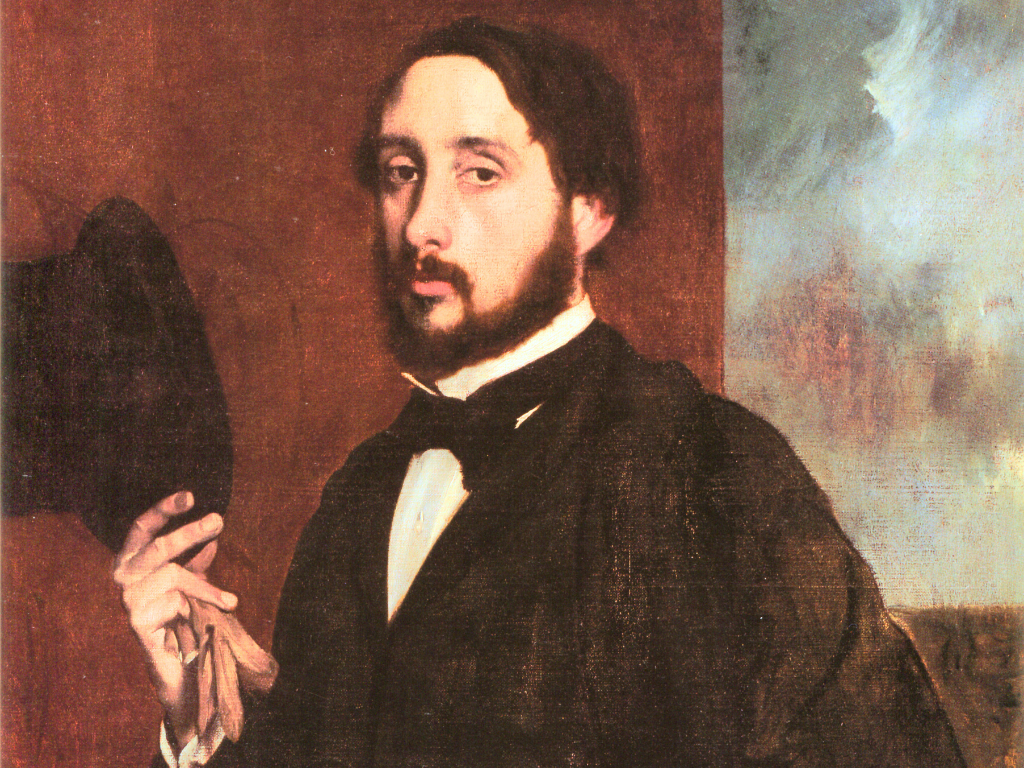
Born into a wealthy Parisian family, Degas trained at the École des Beaux-Arts and studied Old Masters in Italy before developing his own unique style.
Throughout his life, he remained deeply committed to the study of the human form, whether in motion or at rest, and produced an extraordinary body of work that continues to inspire artists and captivate viewers today.
Despite his growing blindness in later years, Degas never stopped creating, and his legacy endures as one of the great visionaries of modern art.
Best Edgar Degas Paintings
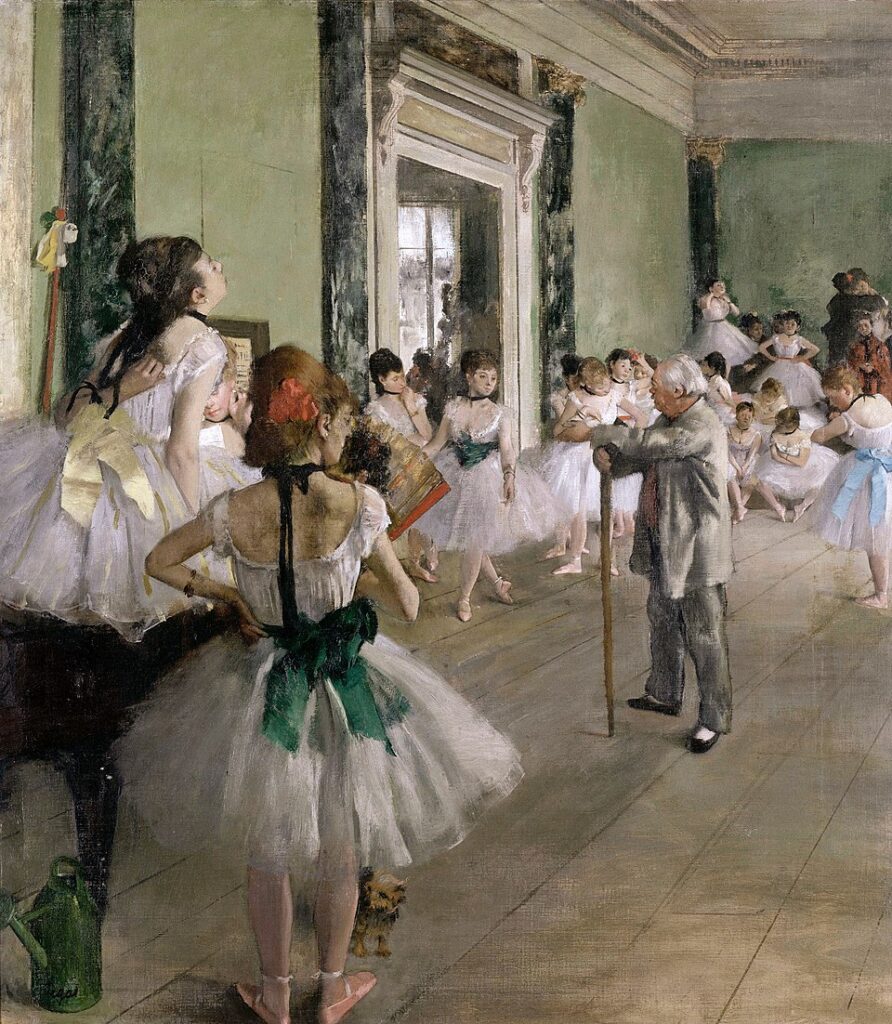
1. The Ballet Class (1871-1874)
Painted in the aftermath of the Franco-Prussian War, The Ballet Class is one of Degas’s earliest major works featuring dancers, a subject that would become his signature.
Commissioned by opera singer Jean-Baptiste Faure, this painting shows a group of ballerinas practicing under the guidance of ballet master Jules Perrot.
What’s striking is the composition: Degas invites us into an almost voyeuristic space, filled with casual postures and subtle chaos, far from a polished stage performance.
The muted tones and sketchy brushstrokes give it a feeling of immediacy, as if we’ve stepped into the room mid-rehearsal.
It’s an intimate, behind-the-scenes look at the disciplined world of ballet.
🎨Where to see The Ballet Class: Musée d’Orsay, Paris, France
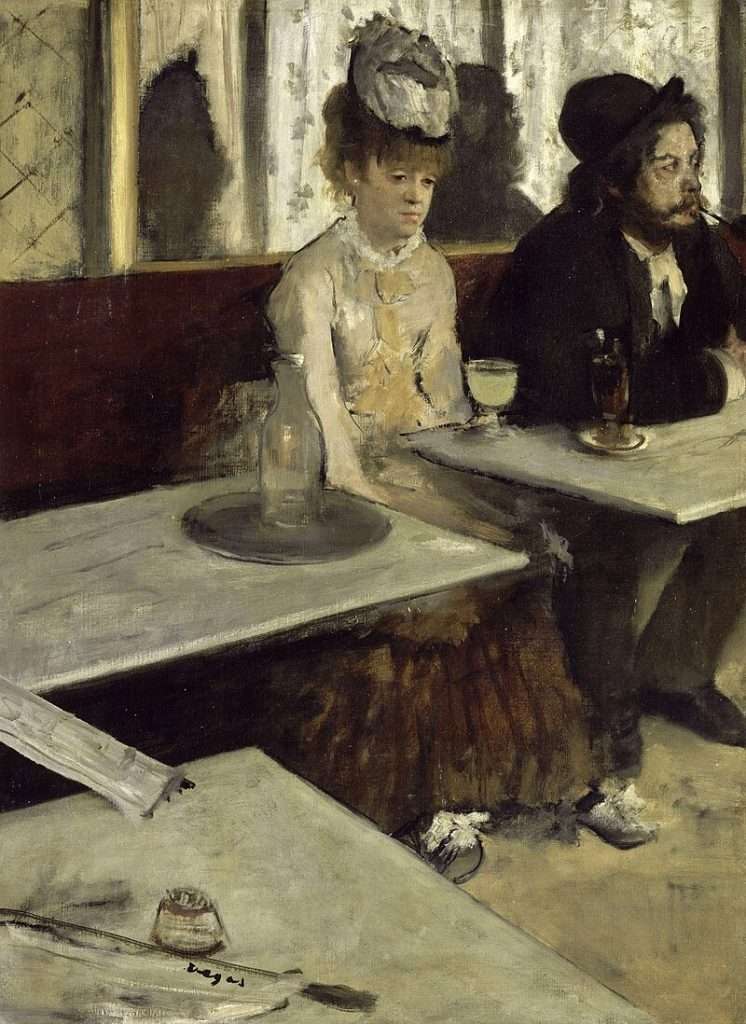
2. L’Absinthe (1875-1876)
One of Degas’s most controversial works, L’Absinthe captures the melancholic stillness of two individuals seated at a Paris café.
Model Ellen Andrée and artist Marcellin Desboutin pose as drinkers under the influence of absinthe—a popular, yet infamous, spirit in 19th-century France.
The painting stirred outrage when it was first exhibited in London in 1893, with critics calling it a depiction of moral decay. But beyond scandal, Degas was exploring themes of alienation and urban solitude.
The skewed perspective, the woman’s empty gaze, and the subdued palette all contribute to a mood of disconnection that still resonates today.
🎨Where to see L’Absinthe: Musée d’Orsay, Paris, France
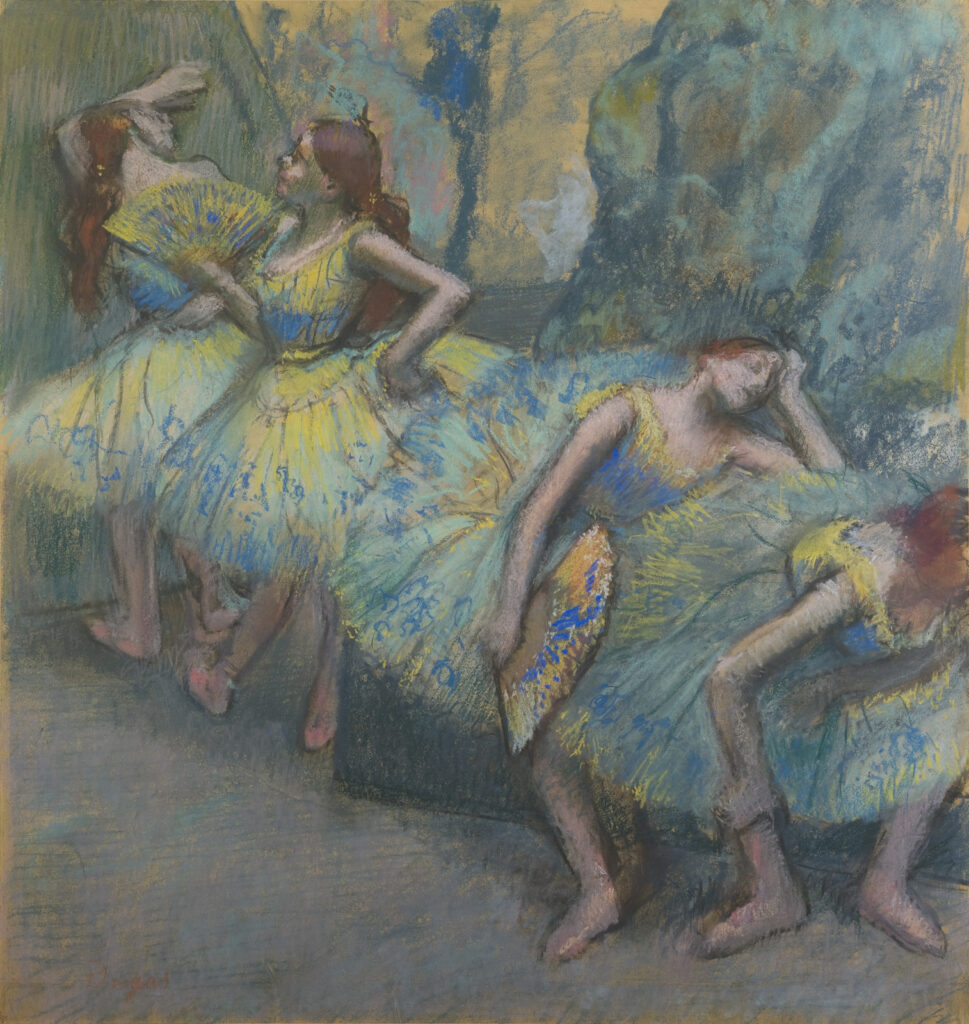
3. Dancers in the Wings (c. 1876-1878)
This pastel painting is another quiet masterpiece in Degas’s exploration of the backstage world.
In Dancers in the Wings, young ballerinas wait for their cue, some stretching, others adjusting costumes.
The lighting and framing feel almost cinematic, highlighting Degas’s fascination with capturing fleeting moments.
He wasn’t interested in idealized beauty; his dancers are caught mid-movement, sometimes even mid-thought.
The use of pastel allowed Degas to layer vibrant colors and create texture that adds both realism and spontaneity. It’s a work that invites you to linger, absorbing every detail.
🎨Where to see Dancers in the Wings: Musée d’Orsay, Paris, France
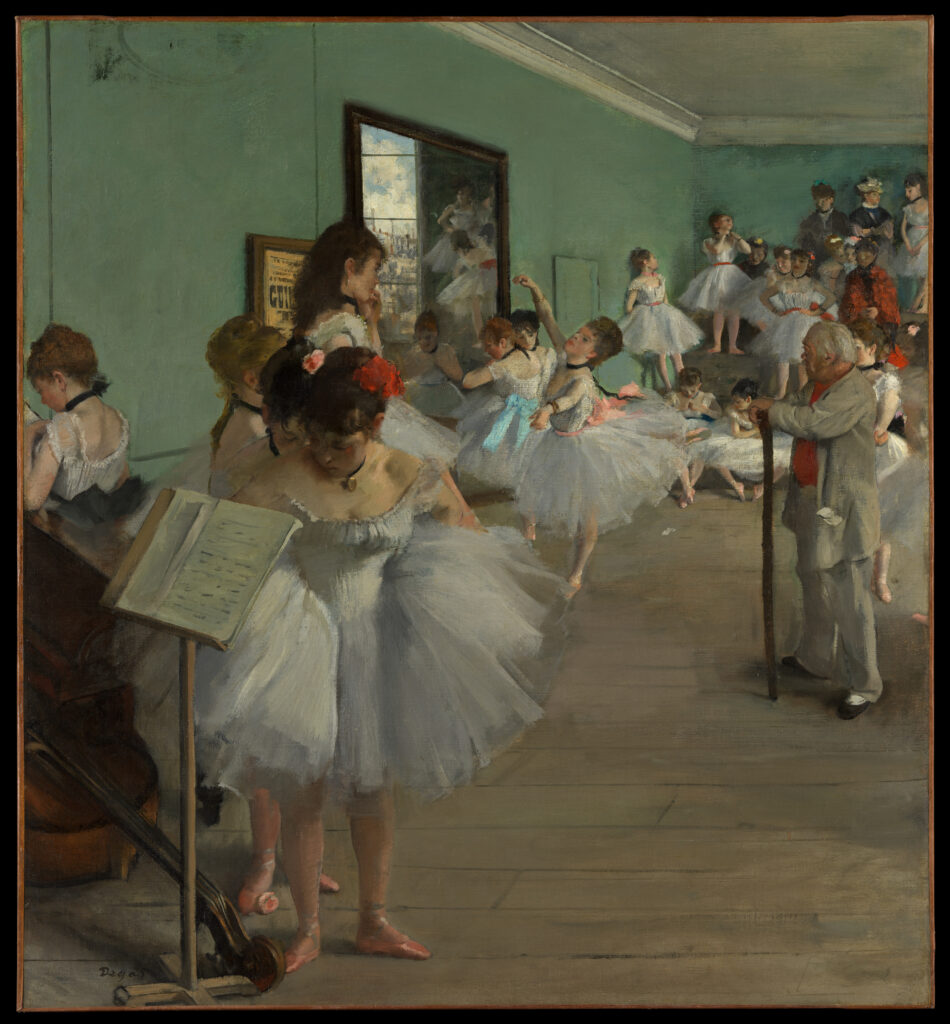
4. The Dance Class (1874)
Often confused with The Ballet Class, this painting was actually completed first and is considered a cornerstone of Degas’s dance series.
Once again, the legendary ballet master Jules Perrot leads a rehearsal, surrounded by young dancers, chaperones, and even a curious little dog.
What makes this piece especially fascinating is how Degas balances chaos and structure.
Each figure seems caught in a different moment, some stretching, others slouching or adjusting their skirts, yet the composition is impeccably organized.
It’s a masterclass in controlled disorder.
🎨Where to see The Dance Class: Metropolitan Museum of Art, New York City, USA
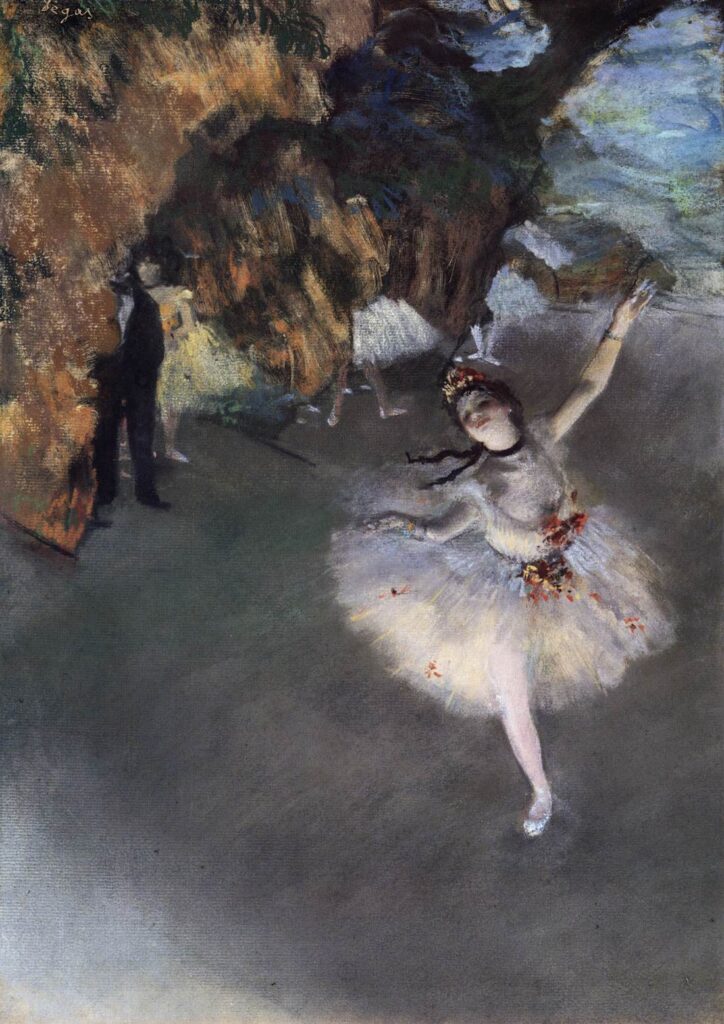
5. The Star (c. 1878)
Location: Musée d’Orsay, Paris, France
One of Degas’s most iconic works, The Star focuses on a single ballerina mid-performance, bathed in the glow of stage lights.
Behind her, a mysterious male figure lingers in the shadows, possibly a patron or stage manager, adding an unsettling undertone to the otherwise graceful scene.
Degas wasn’t simply celebrating the art of dance; he was probing its realities, the pressures, the expectations, and the often-invisible power structures.
His use of pastel creates a luminous, dreamlike quality that contrasts beautifully with the tension of the subject.
🎨Where to see The Star: Musée d’Orsay, Paris, France
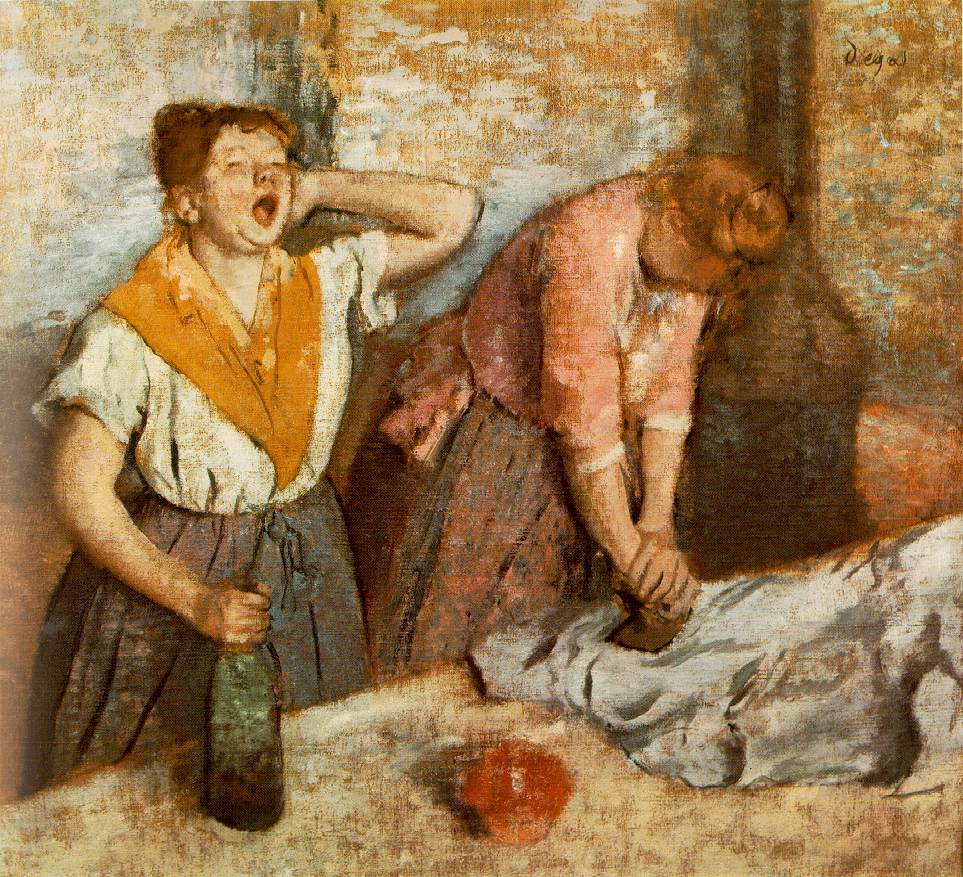
6. Woman Ironing (1873)
Location: Musée d’Orsay, Paris, France
Shifting away from dancers, Woman Ironing is part of Degas’s exploration of working-class life.
This painting shows a laundress mid-task, caught in a moment of fatigue. Her posture, leaning heavily on the ironing table, speaks volumes about the physical toll of her work.
Degas was deeply interested in portraying labor with honesty and dignity.
Here, he captures not just a person, but an entire social reality, rendered with both compassion and realism.
The muted colors and loose brushwork enhance the raw authenticity of the scene.
🎨Where to see Woman Ironing: Musée d’Orsay, Paris, France
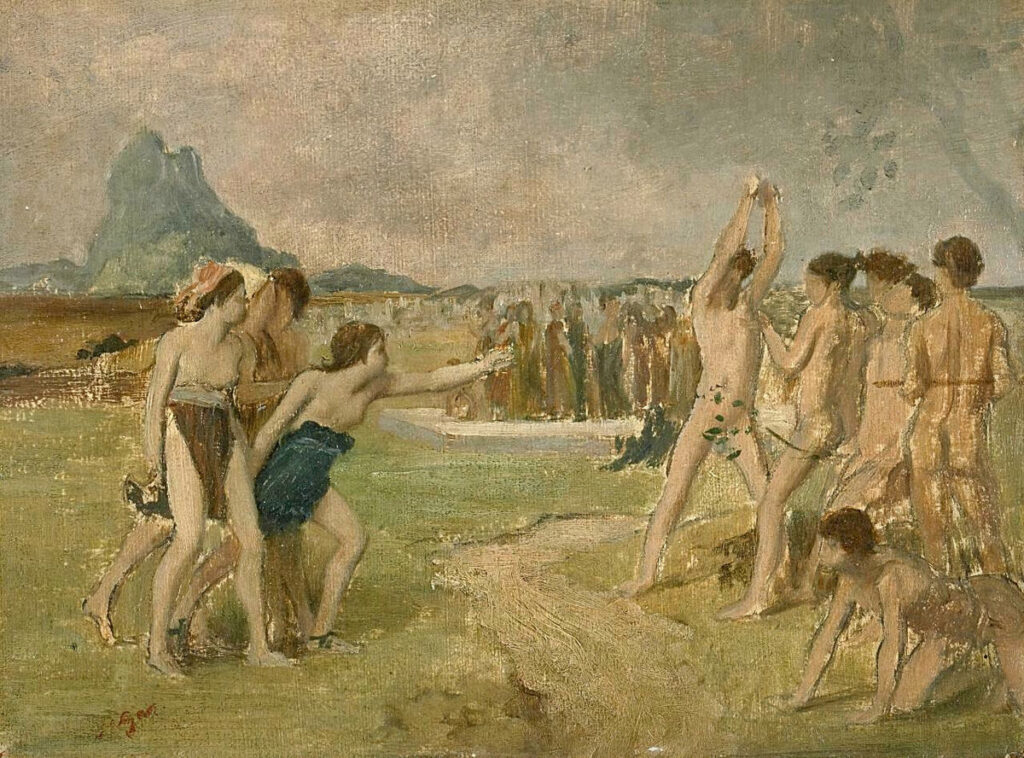
7. Young Spartans Exercising (c. 1860)
One of Degas’s rare ventures into historical painting, Young Spartans Exercising imagines a group of Spartan youths engaging in athletic training, watched by elders.
Though the subject is classical, Degas infuses it with a modern sensibility; his figures are expressive, even confrontational.
He reworked this canvas for years, and its unfinished quality gives insight into his evolving style.
The juxtaposition of nude male bodies and clothed female figures hints at deeper themes of gender roles and societal expectations, making it one of his more intellectually layered works.
🎨Where to see Young Spartans Exercising: National Gallery, London, UK
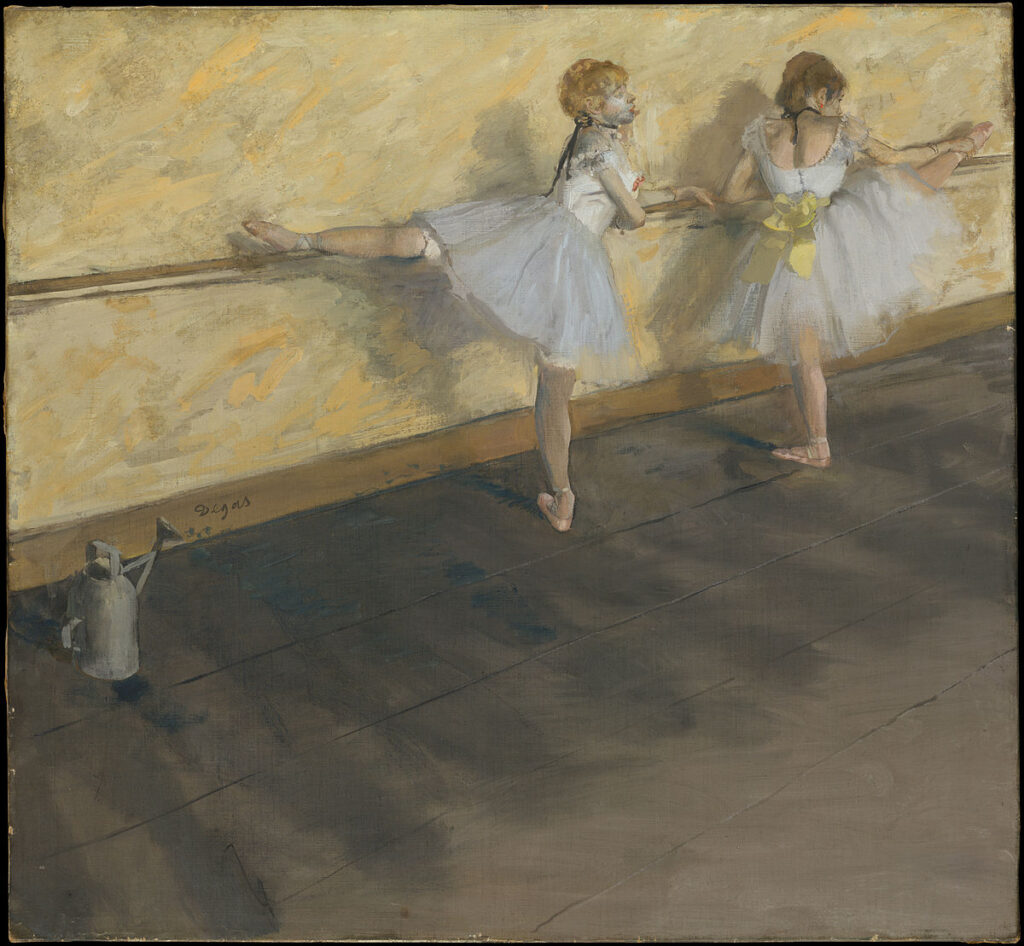
8. Dancers Practicing at the Barre (1877)
This pastel-on-paper masterpiece is a study in form and repetition.
Two ballerinas practice at the barre, their bodies mirroring each other in perfect symmetry.
Degas’s love for drawing and anatomical precision shines through in every muscle and curve.
What sets this piece apart is its use of pastel, a medium Degas mastered in his later years.
The texture and vibrancy allow for dynamic movement, as if the figures might shift at any moment. It’s a quiet but powerful celebration of discipline and grace.
🎨Where to see Dancers Practicing at the Barre: Metropolitan Museum of Art, New York City, USA
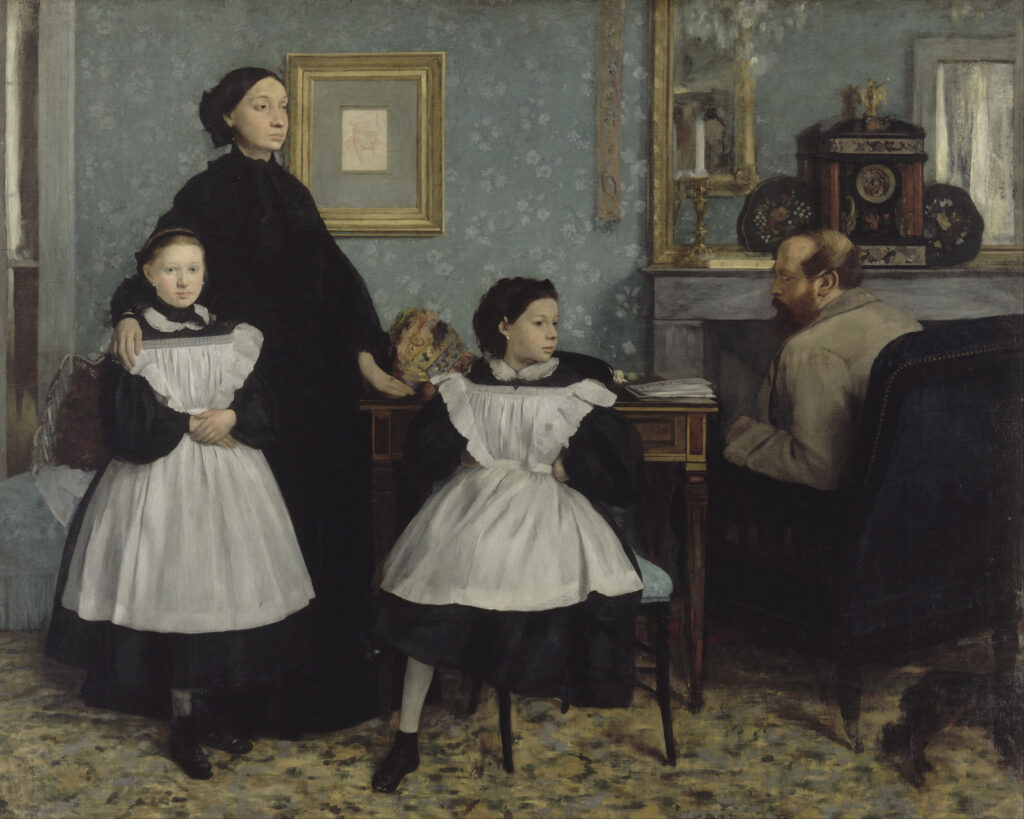
9. The Bellelli Family (1858-1867)
A deeply personal work, The Bellelli Family portrays Degas’s aunt, her husband, and their two daughters.
Painted during his stay in Italy, it reveals Degas’s early genius in portraiture and emotional nuance.
The tension in the painting is palpable; the father sits isolated, while the mother and children appear emotionally distanced from him.
Art historians often cite it as a visual representation of family discord, with every detail, from posture to spacing, contributing to the psychological depth of the composition.
🎨Where to see The Bellelli Family: Musée d’Orsay, Paris, France
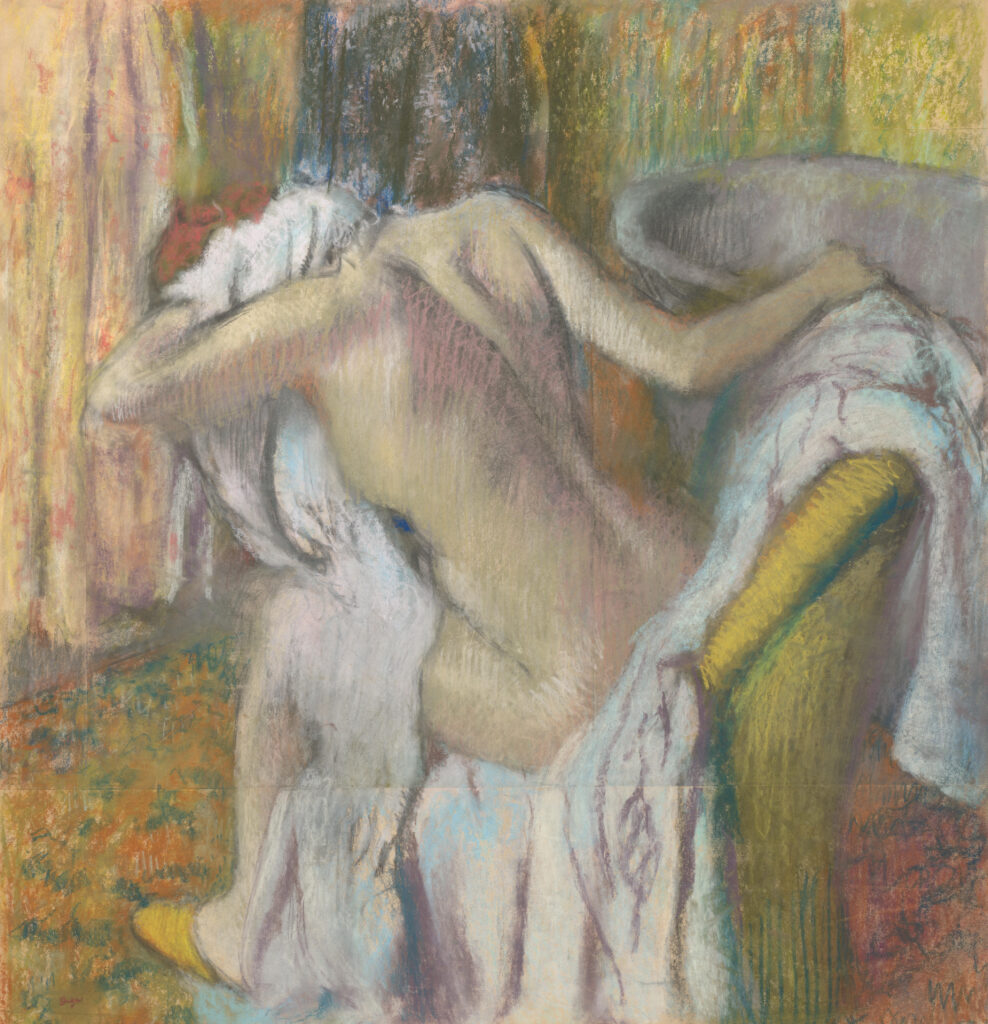
10. After the Bath, Woman Drying Herself (1890-1895)
In this pastel work, Degas returns to another of his favorite themes: the female nude.
But unlike traditional academic nudes, After the Bath shows a woman in a candid, unguarded moment.
She’s not posing, she’s simply drying herself.
Degas’s fascination was less with eroticism and more with privacy and routine.
The soft, layered pastels give the scene a delicate, tactile texture, while the subject’s turned back maintains a respectful distance. It’s as much about solitude as it is about the body.
🎨Where to see After the Bath, Woman Drying Herself: National Gallery, London, UK
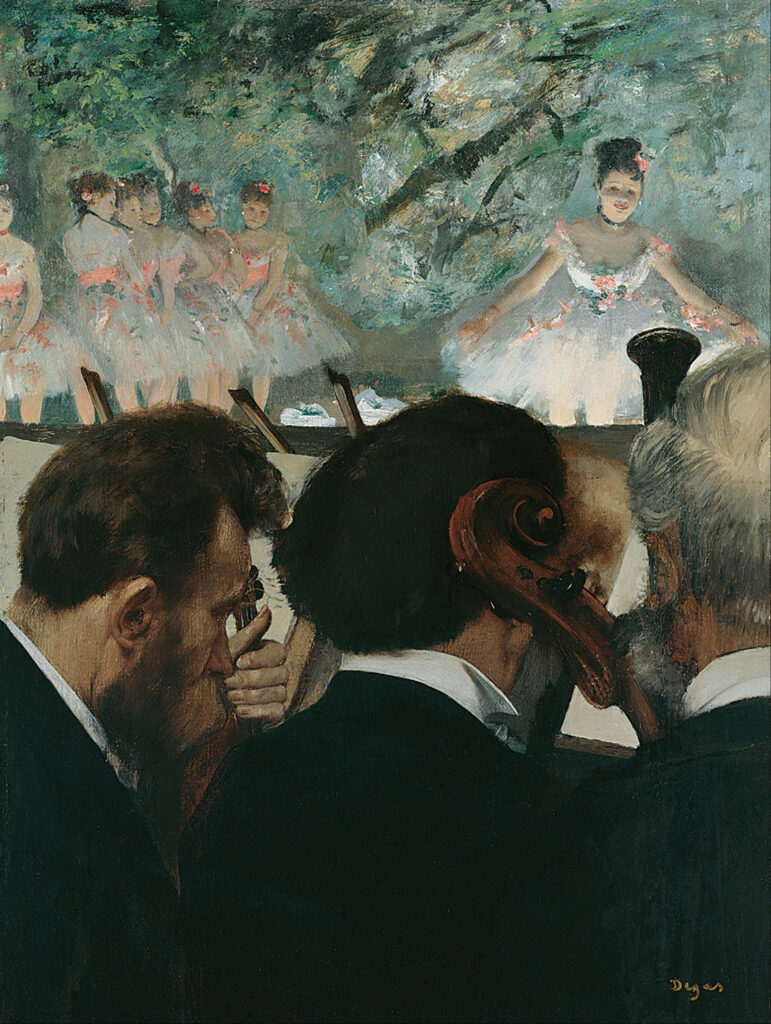
11. Orchestra Musicians (1872)
This painting is a fascinating hybrid, part portrait, part performance scene.
The musicians in the orchestra pit are rendered in exquisite detail, especially the prominent bassoonist, who was a friend of Degas.
Above them, the legs of ballerinas peek out from the stage.
Degas loved unusual angles, and this work exemplifies his experimentation with perspective.
He places the viewer not in the audience, but practically on stage or in the pit. It’s a clever composition that blurs the line between observer and participant.
🎨Where to see Orchestra Musicians: Musée d’Orsay, Paris, France
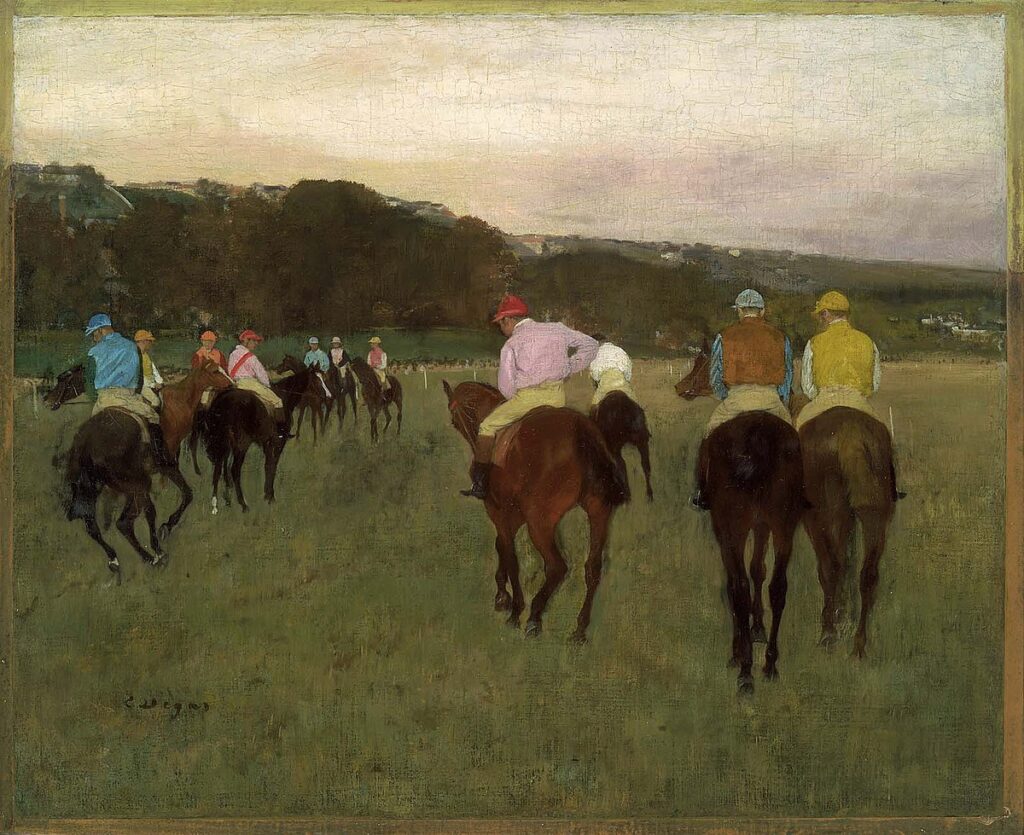
12. Racehorses at Longchamp (1871)
Horse racing was another of Degas’s favorite subjects, and in Racehorses at Longchamp, he captures the tension and energy before the starting bell.
The horses are restless, their jockeys alert, the landscape stretching quietly behind them.
What’s remarkable here is how Degas balances movement and stillness.
His study of horses wasn’t just artistic; it was almost scientific. He made countless sketches, observing anatomy and motion with the precision of a biologist.
The result is a painting that vibrates with anticipation.
🎨Where to see Racehorses at Longchamp: Musée d’Orsay, Paris, France
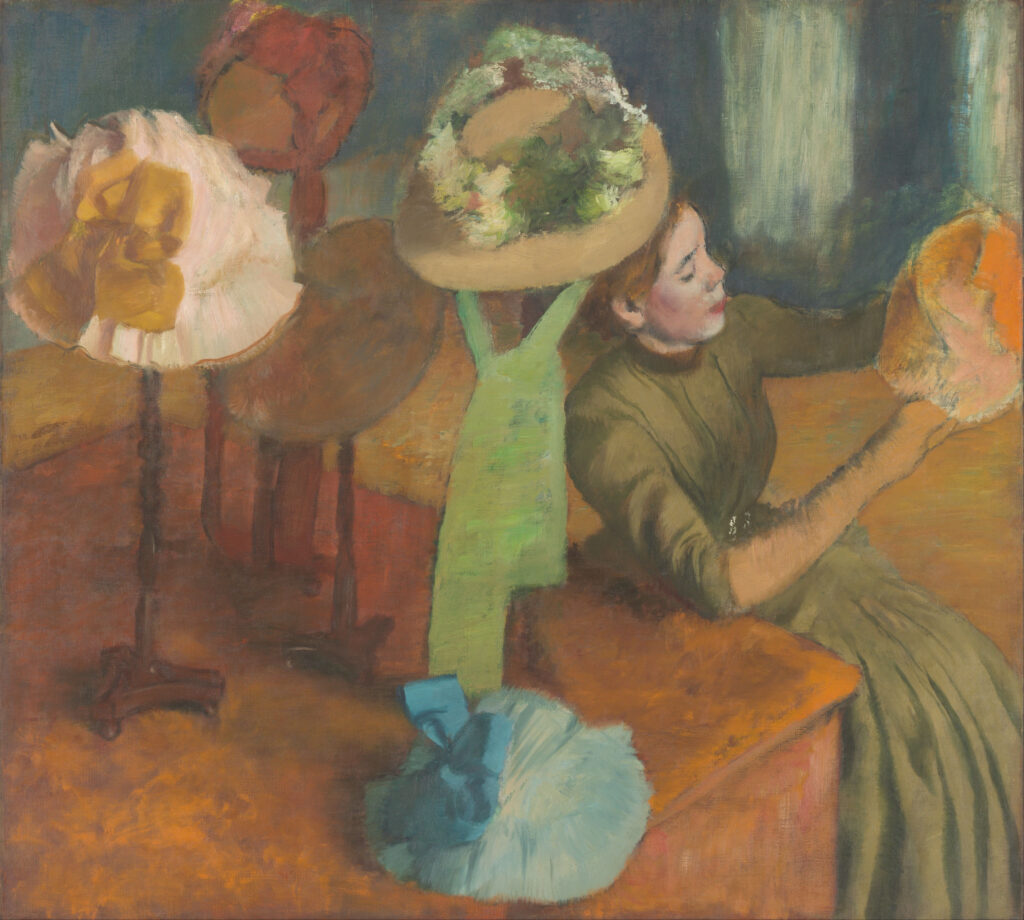
13. The Millinery Shop (1882-1886)
Location: Art Institute of Chicago, USA
This painting offers a rare glimpse into the world of milliners, women who crafted fashionable hats for Paris’s elite.
The lone figure in The Millinery Shop is surrounded by vivid hats, yet her demeanor is subdued, almost reflective.
Degas was intrigued by the intersection of fashion, femininity, and labor.
The way he renders the fabrics and forms is almost sculptural, and his composition places the viewer in the midst of the shop, invited to observe but not interact.
It’s both a study of work and a subtle commentary on consumer culture.
🎨Where to see The Millinery Shop: Art Institute of Chicago, USA
Conclusion
Edgar Degas was a master of capturing the quiet, in-between moments, the seconds of stillness before a dancer takes the stage, the weary pause of a laundress, the concentrated gaze of a jockey.
Through a blend of classical technique and radical innovation, he gave us a new way of seeing the world, one that values honesty, imperfection, and fleeting beauty.
Whether you’re standing in front of one of his canvases at the Musée d’Orsay or the Met, or just admiring them from afar, Degas’s paintings have a timeless power.
They whisper rather than shout, but their voice is unforgettable.
Read More:




